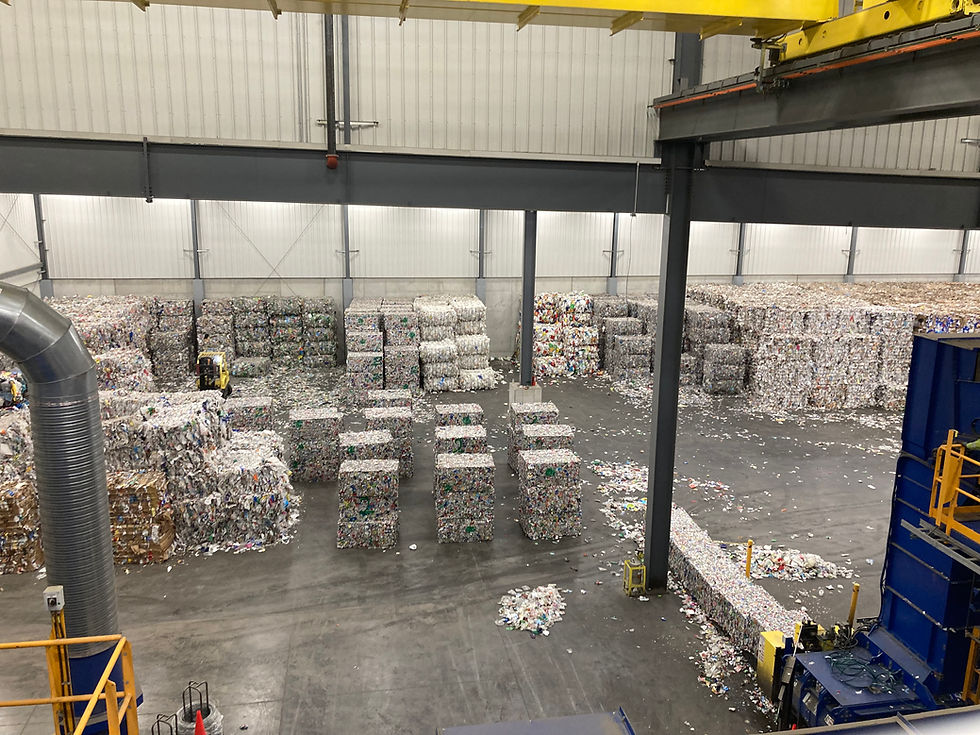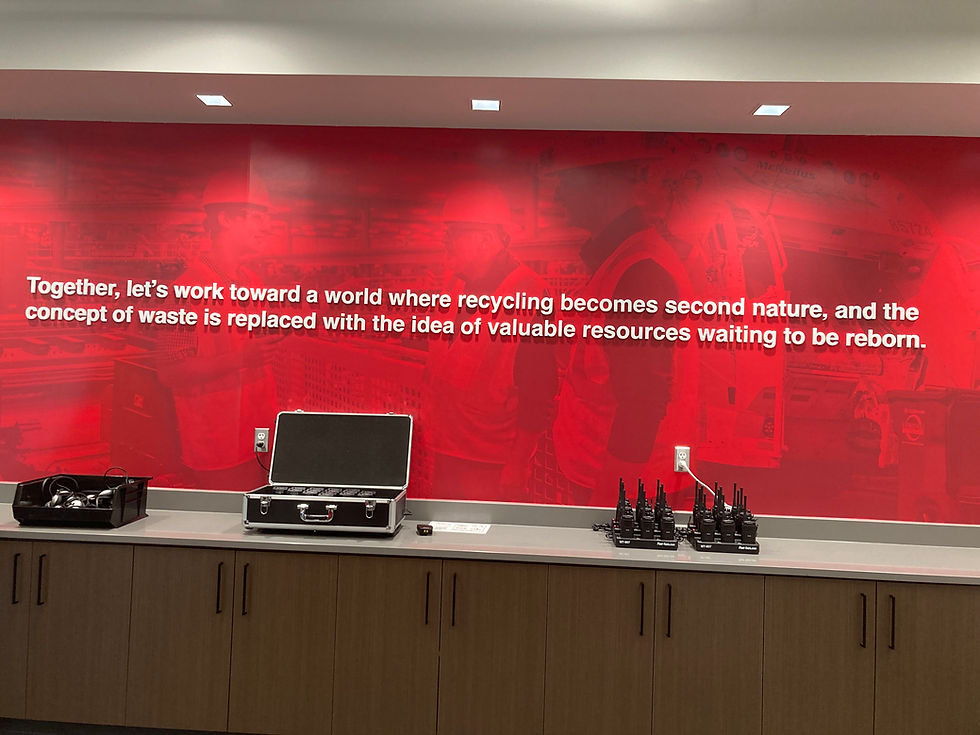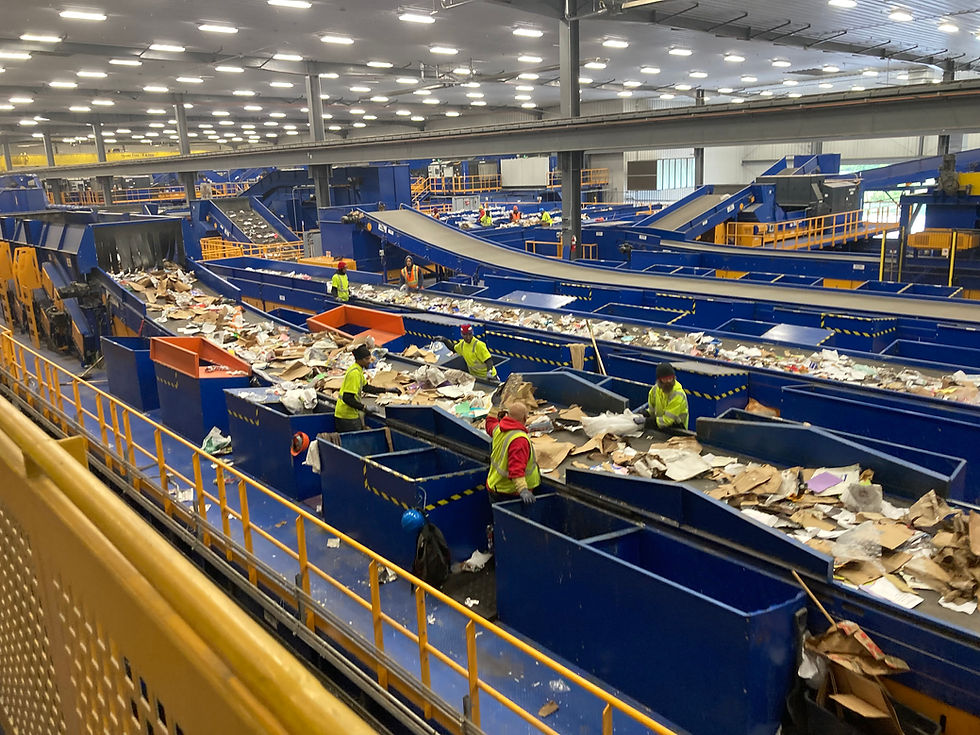Takeaways from a Recycling Center Catwalk
- Jill Hofbauer

- Jun 18
- 4 min read
I have always wanted to visit a recycling center, and recently I had the chance to tour a new facility considered the largest and most technologically-advanced on the continent.

The Rumpke Recycling and Resource Center in Columbus opened its doors less than a year ago, just 30 minutes from my house. The sprawling, multimillion dollar campus includes a comprehensive Education Center and offers residential and commercial recycling for 55 counties in Ohio. From mechanical sorters used to separate materials by physical properties, to optical scanners that use AI to analyze and sort items quickly on a conveyor belt, this facility can process up to 250,000 tons of material every year — a figure as impressive as it is sobering.
Perhaps a new standard, the Rumpke facility offers an example of what can be accomplished when we use human ingenuity and technology to help us manage our environmental impact. But as I walked along the catwalk overlooking the plant of this state-of-the-art facility — wearing the provided hard hat, goggles and neon vest, tuning in closely to the tour guide's voice on my headset — I couldn’t shake a nagging feeling: is something packaged so greatly really addressing the problems of our exorbitant waste crisis?
A complicated question with a multifaceted answer, I ultimately left the facility that day with more optimism than doubt, and came away from the experience with new insight, greater understanding and an even bigger promise to myself moving forward. These are some unexpected takeaways from my visit.
The term Recycling Center does not mean exactly what I thought.
This isn’t a place where new products are made from recycled materials. Rather, it’s a place of processing and shipping. All materials that come through the Rumpke Recycling Center are separated and baled by material type, then moved to a bunker where they await delivery to various manufacturers who then melt the materials down to become new products.

Recycling is a growing and profitable sector in the economy.
The benefits of recycling reach beyond environmental conservation. The recycling industry contributes to a lot of economic activity through things like job creation, tax revenues and innovative circular economies. For individuals, this may translate to reduced landfill costs or lower prices on manufactured goods made from recycled materials. For businesses, it can lead to reduced production costs, tax incentives and increased revenues.
There is a lot of potential in how recycling can build and benefit the economy while simultaneously promoting a healthier planet. In the case of Rumpke, who not only has municipal contracts but sells recyclable materials to manufacturers and circular-economy partnerships, it can be a profitable business endeavor.

For the sorting process to really work, we actually have to recycle right.
Even when we think we've got a good understanding of how to recycle properly, it doesn't hurt to brush up our knowledge regularly. I was glad to learn some helpful new information that day about how to recycle better. Guidelines can vary from one center to another and sometimes it can be confusing, but by becoming our own advocates, educating ourselves on what items can be recycled locally and asking questions when we are unsure, we can help to avoid the pitfalls that come from “wish-cycling,” and send our items to the curb with greater confidence.

Recycling is important and necessary, but it’s only one part of the solution to our waste problem. That is why I have made a promise to myself: REDUCE, REDUCE, REDUCE.
As much as possible, but especially plastic.
Though Rumpke boasts a 98% recycling success rate at this facility, ultimately a portion of what they receive still must go to the landfill. As I watched a conveyor belt take away a stream of unaccepted items (mostly plastic packaging), I realized how much power I actually have as a consumer to decide the amount of waste I create by what I choose to buy and use. Our convenience-based world sometimes robs us of that awareness, but there is a lot of value in realizing that we can actually make wiser choices that don't require a need for recycling at all.
As for my experience touring "North America's largest recycling facility," I'm glad I finally have a first-hand account of what happens to my recycling after it makes its way to the plant. And it's encouraging to find examples of what can be accomplished when people apply critical, sustainable thinking to business processes, turning environmental challenges into innovative, earth-friendlier opportunities.
Until Next Time,
Jill Span Hofbauer



Very insightful and informative. Thanks for the reminder to help do our parts.
A+ content